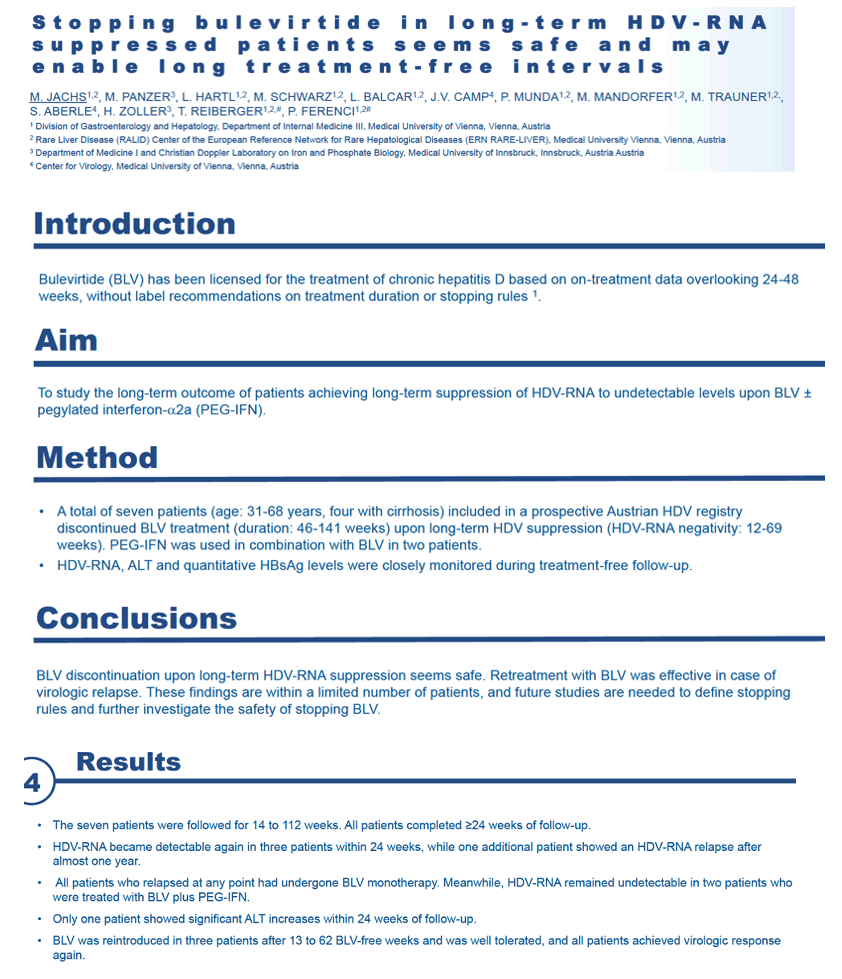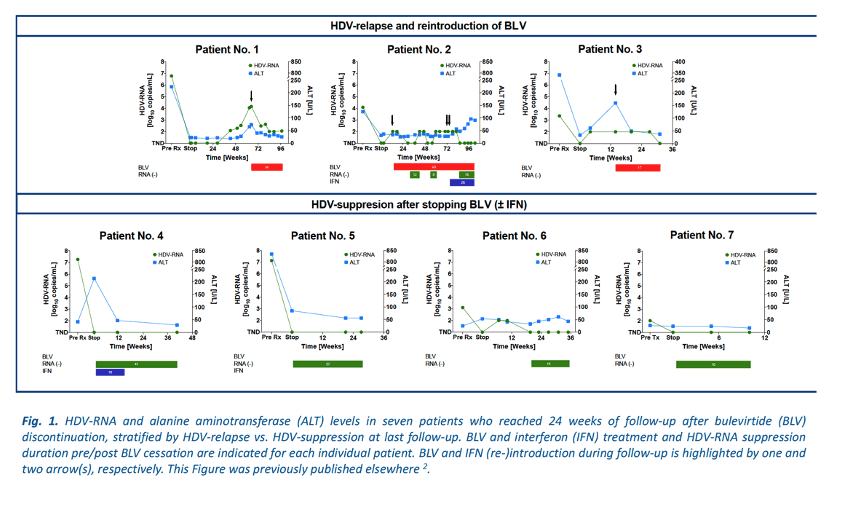 |
 |
 |
| |
Stopping Bulevirtide After Long-Term HDV Control Appears Safe With Close Monitoring
|
| |
| |
EASL Congress 2023, June 21-24, Vienna
Mark Mascolini
Tight monitoring of 7 people with hepatis D virus (HDV) infection who had long-term undetectable HDV RNA during daily subcutaneous bulevirtide therapy allowed some to stop this novel agent for up to a year or more [1]. Three people had an HDV rebound within 24 weeks of stopping, and a fourth person had a rebound within 1 year in this observational study of individuals tracked in the Austrian HDV registry. Three of the 4 people with rebounds restarted bulevirtide and regained an undetectable HDV load. Researchers from the Medical University of Vienna believe their findings suggest that off-treatment HDV RNA suppression may be possible in some people stopping bulevirtide. The Vienna team published their findings shortly before the EASL Congress [2].
Bulevirtide is a sodium taurocholate cotransporting polypeptide (NTCP) blocker, which means it binds the sodium/bile acid cotransporter of HDV and HBV and thus prevents both HDV and HBV from entering liver cells [3]. HDV depends on HBV coinfection for propagation. European regulators licensed bulevirtide for treatment of HDV infection based on 24- to 48-week data [4] but offered no advice on treatment duration or stopping rules. The US FDA has so far declined to license bulevirtide for HDV and compensated liver disease because of "concerns about the manufacture and delivery of the therapy" [5]. Bulevirtide is the only medication licensed for HDV in Europe; none are licensed in the United States.
The Vienna analysis involved 7 people from a prospective Austrian HDV registry who reached an undetectable load with bulevirtide, 5 with monotherapy and 2 with added pegylated interferon-α2a (PEG-IFN). Treatment lasted from 46 to 141 weeks, and HDV suppression from 12 to 69 weeks. These people ranged in age from 31 to 68 and 4 had cirrhosis. After bulevirtide stopped, health workers closely monitored participants' levels of HDV RNA, alanine aminotransferase (ALT), and hepatitis B surface antigen (HBsAg), a marker of active HBV infection.
Follow-up lasted from 14 to 112 weeks after bulevirtide stopped. HDV RNA became detectable again within 24 weeks in 3 people and within 1 year in another person. None of these 4 rebounders took PEG-IFN with bulevirtide. Two people who did receive PEG-IFN with bulevirtide maintained an undetectable HDV load through follow-up, as did 1 who had taken bulevirtide alone. Only 1 person had a significant ALT jump within 24 weeks of stopping bulevirtide.
Three people with an HDV rebound restarted bulevirtide after 13 to 62 weeks without the drug. They all tolerated this second course of bulevirtide well and regained an undetectable HDV load.
The Vienna investigators believe their results suggest suspending bulevirtide after long-term HDV suppression "seems safe" and could permit treatment-free breaks from this daily subcutaneously injected drug. They stressed that their findings need confirmation in a larger number of people to formulate stopping rules for suppressive bulevirtide.
An open-label phase 2 trial in Germany and Russia enrolled 120 people with HDV and HBV who could not take or had not responded to PEG-IFN [4]. Researchers randomized them to tenofovir disoproxil (TDF) alone or to TDF plus 2, 5, or 10 mg of subcutaneous bulevirtide once daily. After 24 weeks of treatment, proportions with undetectable HDV RNA or at least a 100-fold drop in HDV RNA were 54% with 2 mg of bulevirtide, 50% with 5 mg, 77% with 10 mg, and 4% with TDF alone (P < 0.0001 for all three comparisons with TDF alone). When bulevirtide stopped at week 24, HDV RNA rebounded in all participants by week 48. Serious adverse events arose in 9% receiving 5 mg of bulevirtide daily, in 7% of those getting 10 mg, and in 4% taking TDF alone. The investigators recommended studying longer courses of bulevirtide in combination with other antivirals.
References
1. Jachs M, Panzer M, Hartl L, et al. Stopping bulevirtide in long-term HDV-RNA suppressed patients seems safe and may enable long treatment-free intervals. EASL Congress 2023, June 21-24, Vienna. Abstract OS-039-YI.
2. Jachs M, Panzer M, Hartl L, et al. Long-term follow-up of patients discontinuing bulevirtide treatment upon long-term HDV-RNA suppression. JHEP Reports. 2023;6:100751.
https://www.jhep-reports.eu/article/S2589-5559(23)00082-4/fulltext#%20
3. Medscape. Bulevirtide (pending FDA approval).
https://reference.medscape.com/drug/hepcludex-bulevirtide-4000280#10
4. Wedemeyer H, Schöneweis K, Bogomolov P, et al. Safety and efficacy of bulevirtide in combination with tenofovir disoproxil fumarate in patients with hepatitis B virus and hepatitis D virus coinfection (MYR202): a multicentre randomised, parallel-group, open-label, phase 2 trial. Lancet Infect Dis. 2023;23:117-129. doi: 10.1016/S1473-3099(22)00318-8.
https://www.thelancet.com/journals/laninf/article/PIIS1473-3099(22)00318-8/fulltext?dgcid=raven_jbs_aip_email
5. Gavidia M. FDA Rejects bulevirtide for hepatitis D, compensated liver disease. AJMC. November 1, 2022.
https://www.ajmc.com/view/fda-rejects-bulevirtide-for-hepatitis-d-compensated-liver-disease


|
| |
|
 |
 |
|
|